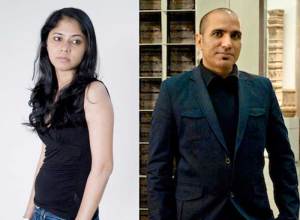56th Venice Biennale
Pavilion of India and Pakistan
My East is your West
Artists: Shilpa Gupta and Rashid Rana
9 May-22 November 2015
According to The Art Newspaper India and Pakistan will be united at the 56th Venice Biennale 2015 in an official joint presentation at the Palazzo Benzon.
“I wish for the [Indian] subcontinent to be a space akin to the European Union, where individuals from neighbouring countries can have the freedom of movement and ideas. Initiatives such as this project may prove to be a journey towards the realisation of this dream, which may not come true in my lifetime, but I hope that it does in my son’s,” said Rana to The Art Newspaper.
In the past, both India and Pakistan have been poorly represented in Venice. After a carefully curated national pavilion at the 2011 biennale—India’s first official representation—the country did not return in 2013. Before that, the country had shown unofficially in Venice eight times since between 1954 and 1982. Pakistan has also had a patchy presence at the biennale, last showing there in 1956, according to a spokesman for next year’s project.
The exhibition is being organised by the Gujral Foundation, which was founded in India in 2008 by Mohit and Feroze Gujral, the son and daughter-in-law of the Indian Modernist artist, Satish Gujral. The non-profit organisation supports contemporary art and design on the Indian subcontinent.
Shilpa Gupta (b.1976) lives and works in Mumbai, India where she has studied sculpture at the Sir J. J. School of Fine Arts from 1992 to 1997.
She has had solo shows at Contemporary Art Center in Cincinnati, Museum voor Moderne Kunst in Arnhem, Arnolfini in Bristol, Castle Blandy in France, OK Center for Contemporary Art in Linz amongst other institutions. She has had gallery solos with Gallerie Yvon Lambert in Paris, Chemould Prescott Road in Mumbai, Galleria Continua in San Gimignano, and at the public gallery, Lalit Kala Akademie hosted Vadehra Gallery, New Delhi.
Shilpa has been invited to the Younger Than Jesus Triennale at New Museum, New York; Lyon Biennale ‘09 curated by Hou Hanru; Gwangju Biennale ‘08 directed by Okwui Enwezor and curated by Ranjit Hoskote; Yokohama Triennale ‘08 curated by Hans Ulrich Obrist; Liverpool Biennale ‘06 curated by Gerardo Mosquera and biennales at Auckland, Seoul, Havana, Sydney and Shanghai.
Gupta’s work has been shown in leading international institutions and museums such as the Tate Modern, Serpentine Gallery, Fondazione Sandretto Re Rebaudengo, Daimler Chrysler Contemporary, Mori Museum, Solomon R. Guggenheim Museum, New Museum, Chicago Cultural Center, Louisiana Museum and Devi Art Foundation in Gurgaon amongst others.
In 2012 she designed the book ‘dates.sites: Project Cinema City Bombay/Mumbai’, edited by Madhusree Dutta. She has co-facilitated ‘Crossovers & Rewrites: Borders over Asia Museum of Contemporary Art, World Social Forum, Porto Alegre’ in 2005 and ‘Aar Paar, a public art exchange project between India and Pakistan alongwith Huma Mulji from 2002 – 2006.
In 2013 she had solo shows at the MAAP Space in Brisbane, Australia and Galerie im TaxisPalais in Innsburg, Austria and participated in Sharjah Biennale curated by Yuko Hasegawa and No Country at Solomon R. Guggenheim Museum.
Rashid Rana was born in Lahore, Pakistan in 1968 where he lives and works. He trained as a painter at the National College of Arts in Lahore and at the Massachusetts College of Fine Arts in Boston. He is the founding faculty member and head of the Fine Art department at Beaconhouse National University in Lahore.
Recent solo exhibitions include a major mid-career retrospective of 70 works, entitled Labyrinth of Reflections at Mohatta Palace Museum, Karachi (2013), as well as surveys at Cornerhouse, Manchester (2011) and Musée Guimet, Paris (2010). Participation in major group exhibitions includes the Kiev Biennial (2012); Fotomuseum Winterthur, Whitechapel Gallery and Saatchi Gallery, London (2010); the Asia Society, New York (2009), the fifth Asia Pacific Triennale, Queensland Gallery of Art, Brisbane (2006) and the Singapore Biennial (2006).
Widely considered to be the leading Pakistani artist of his generation, Rashid Rana first came to prominence in South Asia alongside artists such as Subodh Gupta, before gaining wider, international exposure after the millennium. In his photography, sculpture and digital printmaking, Rana transposes imagery from one time and place to another, through manipulation, repetition and rearrangement. His early photomontages – originally made by painstakingly reconfiguring tiny squares of imagery into micro-mosaics by hand, latterly by using computer software – superimposed hardcore pornography on to the silhouette of the burqa (Veil, 2004) and turned hundreds of graphic slaughterhouse snapshots into facsimiles of Persian rugs (Red Carpet, 2007).
Rana’s telescoping of politics, civilizations and time also appears in three-dimensions, in works from the series Desperately Seeking Paradise (2007-2011), which splice Lahore’s humble streets and houses with the architectural promise of skyscrapers and the slick lines of Minimalism. The new wall-sized Crowdsare similarly tumultuous composites formed of innumerable multitudes of human protest and unrest. Another continuing body of work, produced under the heading Language, crosses the cultural rubicon between historical and contemporary art, obliterating iconic works by Jacques Louis David and Gerhard Richter with data streams made up of horizontal strips of miniature interlocking bytes of visual information.
Image: The Mumbai-based artist Shilpa Gupta (left) and the Lahore-based Rashid Rana. Photo via The Art Newspaper.


